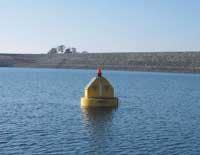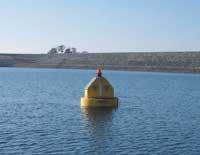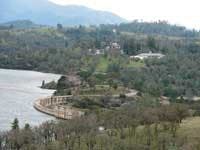By Danielle Dumont
Each morning John Johnson drives the few miles from his small–town home in northern California to the Center at Pardee Reservoir. Nestled among the foothills of the Sierra Nevada mountain range, the reservoir is a long 100 miles away from San Francisco Bay. But this quiet outpost is the crucial origination point for the collection of drinking water that will serve 1.3 million residents on the east side of the Bay including the cities of Oakland and Berkeley.
“Our challenge, but also our silver lining, is our remote location,” said Johnson, Assistant Superintendent for Water Quality at Pardee Reservoir. This silver lining hinges on Pardee’s location in an undeveloped area with little pollution – a clean 577–mile watershed around the Mokelumne River. Situated in the historic “heart of the mother lode” region in California, this water has become as precious as the gold discovered in nearby mines 150 years ago.
The challenge Johnson faces is protecting and delivering this prized water to customers many miles away. For this, the East Bay Municipal Utility District (EBMUD), Johnson’s employer, has a well–planned and carefully monitored treatment and distribution network.
Rain and snowmelt runs into the Mokelumne River and flows into Pardee Lake, where it is stored for use. From here it is released into large aqueducts, which transport the water approximately 90 miles downhill. The aqueduct system is the second crucial point in EBMUD’s network; in here the water is protected from pesticides, agricultural and urban runoff, municipal sewage, and industrial discharges it may encounter on its journey.
“Filter cloggers,” which grow naturally in the reservoir and wind up at the aqueduct’s terminus, are one of the few water quality issues encountered by Johnson and his staff. These cloggers are usually diatoms, microscopic algae found in the water. They create additional treatment costs before the water can be distributed to customers. The team has started to evaluate the use of a multiparameter water quality sonde with a chlorophyll sensor from YSI Inc. This could provide advanced notice of the presence of or change in diatom biomass – giving EBMUD’s terminal plant operators a heads–up for deciding how to deal with the nuisance.
Monitoring chlorophyll concentrations can help control the amount, and thus the expense, of treatment chemicals needed to keep algae levels in check. Although recently promoted into his position, Johnson says that he is looking for results like this and wants to put the YSI technology to full use. The sonde provides additional daily data sets: pH, turbidity, specific conductance, water temperature – all the parameters required by the EPA and the state of California.
pH is another critical parameter. End up on the low end of the pH scale and Johnson knows that the interior linings of the aqueducts could be exposed to corrosion. pH readings from equipment including the sonde help the Pardee team determine the amount of lime needed to raise the pH of the naturally acidic water before it enters the aqueduct system – and thus protect the pipelines.
Johnson has more work to do after the water destined for potable use has been released from the dam into the aqueducts. From the Pardee Center, he also keeps an eye on Camanche Reservoir, 10 miles away.
The Camanche Reservoir is the third critical point in EBMUD’s watershed protection system. In conjunction with Pardee, Camanche provides flood control, hydroelectric power, and serves as a control for irrigation supply in the lower reaches of the Mokelumne River. While the Pardee’s primary purpose is drinking water supply, the Camanche is part of an important habitat for several fish species. The Mokelumne River Fish Hatchery was constructed at the base of the Camanche Dam in the 1960s to revive salmon, trout, and other riparian fish stocks practically wiped out by mining and mine waste pollution.
According to EBMUD’s web site, during the 1850s so much of the river’s water was diverted for mining activities that the riverbed was periodically left dry. Along with mine effluent discharge into the river, this seriously compromised the fish habitat. Even after mining operations ceased in the 1940s, the river still experienced periods of drought and low oxygen (DO) levels. Aquatic species that had begun to return continued to be threatened by the fluctuations in their ecosystem, including a prolonged drought from 1987 to 1992.
Although drinking water is its primary concern, EBMUD is also concerned with the well–being of fish and helped establish a management program to control variables within and around the river environment. This includes releasing water flows from Camanche to the lower Mokelumne River.
The bottom layer of water in the reservoir – the hypolimnion – is cooler than the surface but also tends to stagnate.
“We need to monitor and control dissolved oxygen levels in this layer in order to protect the fish,” Johnson said.
Here they use an automated YSI Vertical Profiling System to monitor oxygen levels (as well as several other key water quality parameters) from the top of the reservoir down to the bottom. The profiler gives them a constant supply of vertical data points. It is one tool which helps them decide when to feed liquid oxygen into the lake bottom via a hypolimnatic oxygenating system (HOS). Operation of the HOS is managed and controlled in large part based on interpretation of data from the profiler.
Before, Johnson notes, his busy staff could go out to sample one to two times per week, generating “only a snapshot” of the deep reaches of the reservoir. Now, however, the profiler gives them a detailed picture.
“We are saving some serious amounts of labor by using an automated system,” Johnson said. “Our personnel can now collect more data with less work.”
At weekly meetings, staff reviews water temperature and elevation data and discusses the release of water from the two dams.
“At certain times of the year, it is absolutely critical for us to coordinate this release,” Johnson said. “For the benefit of the Camanche, because we need to mix in cooler water for the autumnal salmon run. And primarily for the benefit of the Pardee, because we need to strike a balance between maintaining lake levels necessary for supplying drinking water to all of our District water users – and the release of water to maintain flood control and storage capacity levels set by the U.S. Army Corps of Engineers.”
Johnson is becoming more comfortable with the breadth of data collection responsibilities required by his job. Right now his staff is discussing the possibility of purchasing a second YSI profiling system and affixing it to a small boat which they can transport between the two reservoirs. Using GPS to find specific sites within the lakes, the staff could quickly take profile readings each week. Pre–programmed monitoring sets would save them a lot of time versus manually lowering instrumentation for multiple vertical measurements.
Outside the office windows at the Pardee Center, Johnson and the team have a great view. Broad green swaths of land, along with the pristine water that runs over it, are the “gold keys” to EBMUD’s water supply. To protect these assets, conservation easements are in place, regulations are adhered to, and technology provides the team with daily updates on the water’s quality.
“One hundred years ago, folks were visionary when they sited and protected the Mokelumne River watershed. They looked ahead 100 years and now we have a safe water infrastructure. Our responsibility now is to meet emerging challenges and provide for its protection for the next 100 years... and beyond.”
About the Author:
Danielle Dumont is a Marketing Communications Manager with YSI Incorporated in Yellow Springs, Ohio. Among other responsibilities, she pursues those “golden nuggets” of stories from customers who use YSI’s water quality instruments and environmental monitoring systems.






